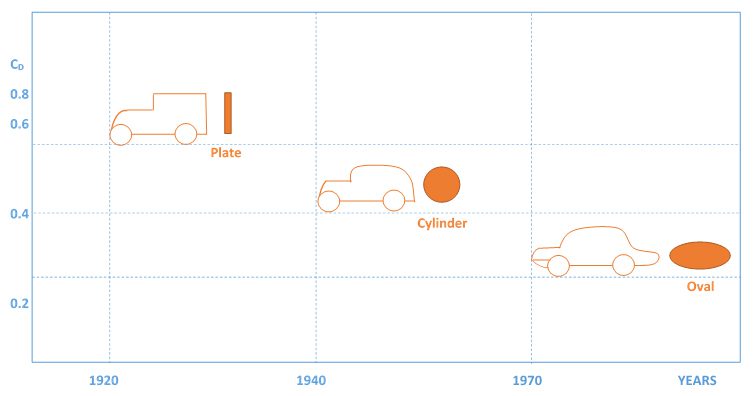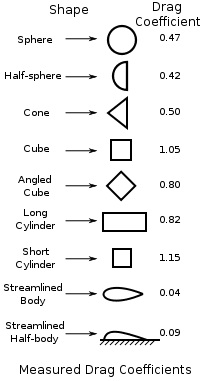Air Resistance On A Car
Vehicle designers, no affair if they specialize in motorsport cars, trucks, common vehicles, or even motorbikes, have to fight every day with an invisible enemy — air resistance. To put information technology simply, when a body moves, the air effectually it generates resistance in the opposite direction of the movement. For vehicles, air resistance affects the condolement of the passengers, fuel consumption, stability, and many other performance factors.
Air Resistance Measuring Air Resistance
Source: By TheOtherJesse, Wikimedia CommonsBelow is the drag equation that represents the drag force 





The equation shows that the only parameters the designer can modify are the reference surface area of the object and the drag coefficient. For automobiles and many other kinds of objects, the reference area is the projected frontal area of the vehicle.
The drag coefficient ranges upwards from 0, and a lower drag coefficient indicates that the vehicle will exist less air-resistant, which reduces the drag coefficient and improves the performance of the vehicle as information technology pertains to speed and fuel efficiency. These are the 2 values that need to be focused on to reduce the aerodynamic resistance of a vehicle.
SimScale'southward CEO David Heiny tests the capabilities of cloud-based simulation to solve an engineering problem. Fill out the form and watch this free webinar recording to learn more!
Air Resistance Design The Development of Streamline Vehicle Design

Some decades ago, when nobody studied the aerodynamics of vehicles, their designs were by and large rather "indigestible," with athwart forms. A lot has inverse since and then, with automobile manufacturers steadily improving the aerodynamics in an effort to make each new model more than shine and 'slippery' than the one before, allowing air to menstruum easily around information technology with the to the lowest degree possible resistance.
Modern vehicle blueprint techniques that aid reduce air resistance include, in addition to the smoothness of the overall vehicle shape, recessing the windscreen wipers and door handles, streamlining outside mirrors, eliminating raised gutters around the edges of the roof, and many more — all of which help reduce drag and foreclose loss of efficiency.
Wind Tunnels & Air Resistance The Introduction of Air current Tunnels in Vehicle Blueprint
These are still adequately recent developments, however. Before the 1980s, a streamlined vehicle design was restricted to racing and high-stop sports cars until the introduction of current of air tunnel testing, which brought aerodynamically optimized consumer vehicles to the marketplace. Wind tunnels soon became one of the well-nigh important tools to meliorate vehicle aerodynamics.
In a wind tunnel, the prototype of the vehicle is fixed in place as a stream of air is diddled towards it to simulate the airflow that the vehicle would come across when driven on a real route. The amount of generated drag is then measured to approximate the drag coefficient and assess the overall aerodynamic performance of the vehicle.
Improving Air Resistance Improving Vehicle Design Aerodynamics with Simulation

Physical air current tunnels had been the manufacture standard for car manufacturers and designers until the introduction of fluid period simulations with virtual wind tunnels. In add-on to the loftier costs of the initial setup, physical wind tunnel testing is time-consuming and can considerably stretch the product design cycle. On the other mitt, computational fluid dynamics (CFD) tools are significantly more efficient and they reduce design costs and fourth dimension to a keen extent while enabling engineers to test their designs nether a much larger variety of operating weather.
To illustrate the application of virtual wind tunnel testing in the external aerodynamic assay of vehicles, nosotros chose several simulation projects from the SimScale Public Projects Library. Our simulation engineers, along with our active community of users, have performed numerous simulations of vehicle aerodynamics, including trucks, sports cars, futuristic vehicles, F1 cars, FSAE, LMP1 race cars, in improver to airplanes, race bobsleds, and other miscellaneous projects.
In the automotive industry, the near focused awarding of car aerodynamics optimization tin exist found in Formula one. Since the late 60s, F1 engineers have been working on the aerodynamics of their cars with a double target: minimize the aerodynamic resistance and maximize the downforce. To achieve both objectives, engineers accept created a lot of different and extravagant solutions. For example, the Brabham BT46B blueprint, which generated a loftier level of downforce using a fan, not just increased cooling simply besides extracted air from below the car.
Air Resistance Determination
Minimizing air resistance and optimizing aerodynamic performance remains one of the key challenges for designers in the car manufacturing industry. It is no longer the sectional domain of race car engineers and has a existent tangible influence on various aspects of the operation of consumer-grade vehicles, including fuel consumption, passenger comfort, and more. However, in that location is no denying that the emergence of virtual prototyping and simulation tools has made tackling this problem far easier than before. If you lot want to learn more about how to minimize air resistance using engineering simulation, first a free trial with SimScale and leverage the platform's CFD functionalities to optimize your own designs.
To larn how to employ SimScale, spotter the "How to Optimize Race Cars with Cloud-Based CFD" webinar in partnership with Racecar Engineering mag. Just fill out this curt form and information technology will play automatically.
Air Resistance On A Car,
Source: https://www.simscale.com/blog/air-resistance-vehicle-design/
Posted by: johnsonarefling.blogspot.com



0 Response to "Air Resistance On A Car"
Post a Comment